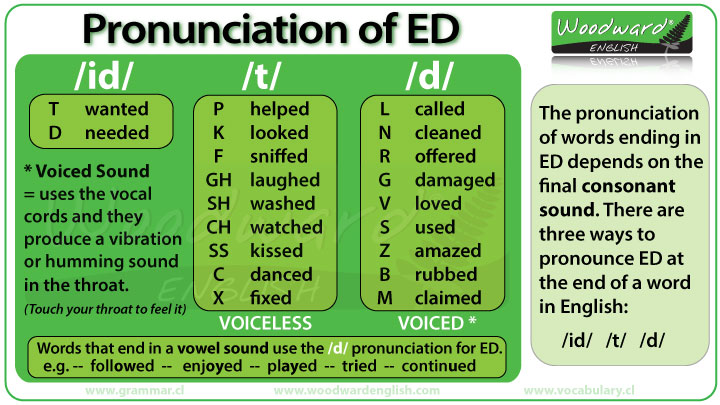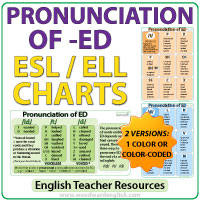Pronunciation of ED
Past Tense, Past Participles and Adjectives
ED appears at the end of regular verbs in the past tense (e.g. wanted, helped, lived) sometimes in adjectives ending in ED (e.g. tired, embarrassed, relaxed) as well as in some Past Participles.
However the pronunciation of ED sometimes causes problems for non-native speakers because it can be pronounced in three different ways: as / id /, as / t / or as / d /
(Note: whenever you see letters or symbols between two slash marks (/ /), it refers to the pronunciation of that letter or sound)
Before we learn the different ways to pronounce ED, we must first know what voiced and voiceless consonants are.
Voiced Consonants vs. Voiceless Consonants
A voiced consonant (or sound) means that it uses the vocal cords and they produce a vibration or humming sound in the throat when they are said. Put your finger on your throat and then pronounce the letter L. You will notice a slight vibration in your neck / throat. That is because it is a voiced sound.
A voiceless sound (sometimes called an unvoiced sound) is when there is no vibration in your throat and the sound comes from the mouth area. Pronounce the letter P. You will notice how it comes from your mouth (in fact near your lips at the front of your mouth). The P sound doesn't come from your throat.
Try this with the other letters and you will "feel" the difference between a voiced and a voiceless consonant (or sound).
Now we know the difference between voiced and voiceless sounds we can look at the following rules for the correct pronunciation of ED in English:
1. The /id/ sound
If the last letter of the word is spelled with D or T, the ED is pronounced as a separate syllable with an /id/ sound (it rhymes with kid and lid).
- wanted (sounds like "want-id")
- waited
- needed
- folded
2. The /t/ sound
If the last consonant of the word is voiceless, then the ED is pronounced as a T. Be careful not to create an extra syllable or "id" sound.
- talked (sounds like "talkt")
- kissed (the S sound comes from the front of mouth so it would sound like "kisst")
- parked
- helped
NOTE: As an example, with the word "helped", if you say "help-id" as a two syllable word, then it is very likely that people will NOT understand the word or what you are saying. (It is pronounced like "helpt")
3. The /d/ sound
If the last letter of the words ends in a voiced consonant (or sound), then the ED is pronounced like a D (without creating another syllable)
- played (sounds like "playd")
- closed (the S sounds like a vibrating Z so the word would sound like "clozd")
- opened
- lived
An easy way to remember how to pronounce ED words
The most important thing to remember is that there are two main divisions:
- The words that end in T or D
- the ED is pronounced as a syllable /id/ - and the REST of the words
- you can pronounce the ED as /t/ and people will understand.
In time you will learn when to pronounce the ED as /t/ or /d/.
Summary Chart
This is the chart that appears in the video.

Next activities
Pronunciation Game:
Try our game to practice these pronunciation rules by answering questions such as "The ED at the end of the word KISSED is pronounced ..." and you then need to choose one of the three alternatives.
Pronunciation of ED in English Game (20 questions)
Pronunciation of ED in English Game 2 (50 questions)
Pronunciation Rules:
You might be interested in the Pronunciation of -S at the end of words in English.
Grammar Rules:
Learn how to use the past tense in English and see our list of Irregular Verbs in the Past Tense.
English Resources
These resources are ideal for ESL teachers or parents:



If you found this guide about the Pronunciation of ED in English useful, let others know about it.
